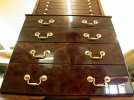- Joined
- Jul 30, 2006
- Messages
- 42,471
Howdy,
Listen to an old paint chemist who's formulated everything from housepaint to aircraft paint:
Nitrocellulose lacquer can give a very high gloss. It will not provide good durability against outdoor exposure.
If you are looking for a high gloss finish that be durable, for a one-part, try a marine varnish or the varnish they sell for bar tops. Paintitred's suggestion of a two-part acrylic urethane would be even more durable.
Listen to an old paint chemist who's formulated everything from housepaint to aircraft paint:
Nitrocellulose lacquer can give a very high gloss. It will not provide good durability against outdoor exposure.
If you are looking for a high gloss finish that be durable, for a one-part, try a marine varnish or the varnish they sell for bar tops. Paintitred's suggestion of a two-part acrylic urethane would be even more durable.

